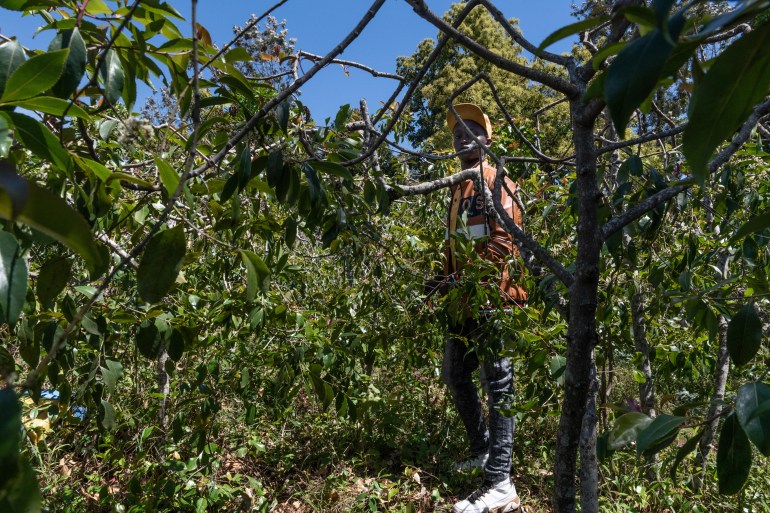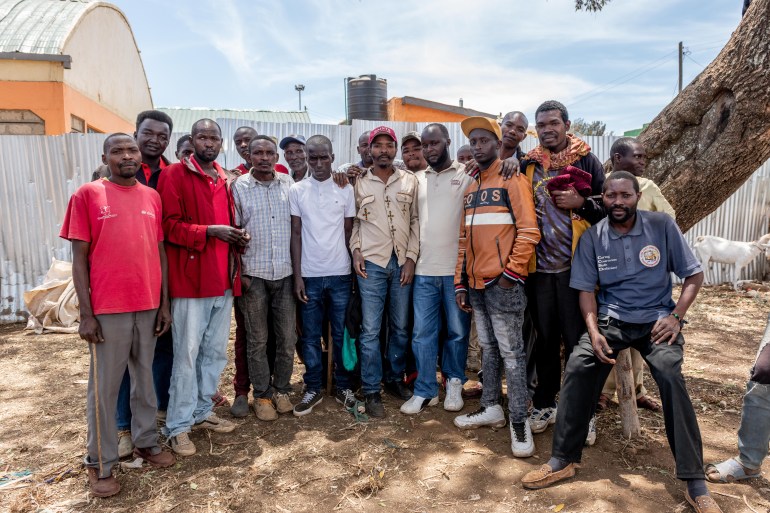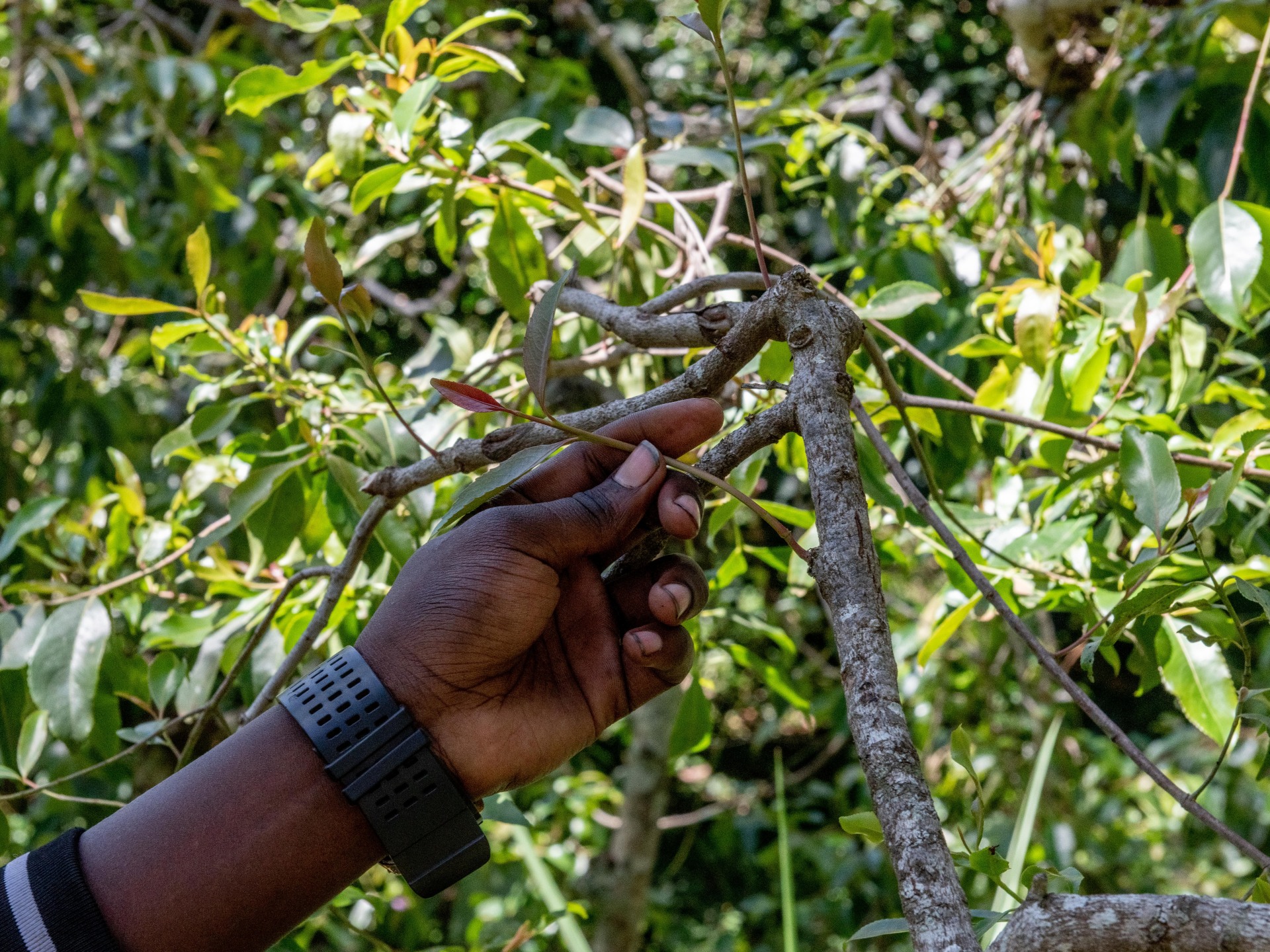Maua, Kenya – Even as drought continues in parts of Kenya, rain has started falling in the hills outside Maua town, in the highland region of Meru, famed for the quality khat grown there.
Farmers like Eric Mwiti have been waiting for a change in weather – and in market conditions.
Mwiti, 28, manages five acres (two hectares) of khat trees on his family’s farm, but even after the expensive drilling of a well to sustain the crop through longer dry seasons, he can only water half his plants.
This is because the market for Kenyan khat is yet to recover from setbacks that started with the coronavirus pandemic of 2020.
“During corona, business was very low,” Mwiti said, “and sometimes we weren’t able to sell our harvest. Now, things are better, but it’s not like it was before.”
Khat, a stimulant leaf with an energising, mildly euphoric effect when chewed, is grown in East and North Africa, where it is both consumed locally and shipped across the Horn of Africa and parts of the Middle East.
The biggest customer overseas for Kenyan khat farmers has been Somalia; farmers ship vast quantities of fresh leaves and stems, picked and transported at top speed to airports, to be sent abroad before they begin to lose their potency.
Until COVID-19 struck, business was great.
Then, for two years, the export of Kenyan khat to Somalia was officially banned, ostensibly over health concerns. Many saw it as a political move, part of a supposed spat between then-presidents Uhuru Kenyatta and Mohamed Farmaajo. The ban tanked the Kenyan market and caused farmers to fire workers and let farms lie fallow.
When trade was reinstated last year, many eagerly predicted a new boom for the cash crop. But so far, khat farmers and traders say that has not materialised, and as they hope to ramp production back up, they are calling on the Kenyan government for support.
“The business is no longer making sense,” said Kimathi Munjuri, the chairman of NYAMITA, a trade organisation representing Kenyan khat farmers, traders and exporters. He said the deal to resume trade between Kenya and Somalia was rushed and a ploy to court political goodwill.
“The government did not take the time for a workable agreement,” Munjuri added.

‘Even the wells go dry’
In Kiengu Market, outside of the main export centres of Maua town, small-scale khat farmers mill around in the shade of a corrugated-aluminium market canopy, holding bundles of freshly picked khat, while buyers sit on mats and stools, casually inspecting the merchandise.
Farmers say they are still feeling the squeeze on the khat market. During the long dry months in Meru, most farms couldn’t produce at a high level. The area has not been as severely affected by drought as northern Kenya, but farmers waited anxiously waiting for rains to begin at the end of the last two dry seasons. But even the long-awaited rains have not been enough.
“Now there’s hot sun, so it’s harder to grow,” said Gilbert Kimathi, one of the farmers. “Even the wells go dry.”
Kimathi, 45, has been cultivating khat in the area for more than two decades, watching the market rise and fall, while the dry seasons grow longer. The pandemic was far and away the worst time he can remember, but he is not optimistic that more rain will fix everything. A sudden surge of fresh crops flooding the market lowers prices, he says. His immediate concerns are those of farmers the world over: the prices of agricultural inputs.
“We need the government to help with building wells and dams for irrigation,” he said. “To organise for buying fertiliser.”
Kenyan President William Ruto has promised many of those things. In an address to farmers in the area before his inauguration last year, Ruto said the agriculture ministry would cut the prices of fertiliser by nearly half, a potential boon to farmers nationwide.
He also announced a plan to build 100 small-scale dams to improve irrigation for Kenyan farmers. But the initiative is targeted at mostly staple crops, ostensibly to increase food security for a nation that imports more than $1.3m in food annually. Cash crops like khat do not appear to be part of the plan.
Khat traders pay a $4.50 per kilogramme commission to khat traders for exports, a fee that industry insiders believe is hampering the capacity to compete with neighbouring Ethiopia.
During Kenya’s exclusion from the market during COVID-19, Ethiopian traders took over and NYAMITA’s Munjuri says Kenyan farmers will be unable to claw their way back in while paying additional fees.
Last year, Ruto met new Somali President Hassan Sheikh Mohamud to address the new commission khat traders reportedly pay to airlines to export their product. According to NYAMITA, the talks yielded no tangible results as traders still pay commissions to ship their product out of Kenya.
“It is pathetic that we have people among us who would like to see something like this continue,” said Munjuri. “They will drive the industry to a halt. You can see the level of selfishness.”
The complications of recent years—from the trade embargo to the drought gripping the Horn of Africa—have affected the market across the border in Somalia, as well.
Sahra Ahmed Koshin, researcher and PhD candidate at the universities of Copenhagen and Nairobi, studied the effects in her home town of Garowe, northern Somalia.
Many local retailers, mostly women, were forced from the business during earlier lockdowns, she said, and have not returned. Now, with the drought, consumption has slowed and prices have jumped. Five kilos of khat now sells for $58, she told Al Jazeera.
“It’s mostly the elite who can afford to chew khat these days,” Koshin said. “This business, it persists. But instead of reducing the prices in situations of drought, the opposite happens: it becomes very expensive.”
But high prices on the Somali side of the border are little help to Kenyan farmers. Hampered by the import tax and lower supplies, they are struggling to produce and ship their khat at profit.

‘We want the government to work’
For Hassan Abdi, 33, a khat trader, not even low import commissions will be enough. He wants the Kenyan government to take a more active role in protecting and promoting khat trade.
“We want the government to find more markets, like London, Netherlands, Djibouti, Congo, even Mozambique,” he said. “We want the government to work to create trade agreements.”
Khat is illegal in many countries including England and the Netherlands, where the Somali diaspora makes up the vast majority of users. The product still finds its way to these consumers, but farmers believe the Kenyan government should be advocating for legalisation to expand their market.
Currently, khat is mostly shipped to Somalia through private charter flights, allowing airlines to dictate prices. Abdi hopes Kenya Airways will establish daily cargo flights to Mogadishu, instead.
Farmers and traders routinely complain about market volatility due to weather, cost of inputs, international trade and geopolitics. They hope the Kenyan government will institute a fixed price for khat, as Ethiopia did in 2022.
Despite the setbacks, Kenyan farmers are still growing what they can.
Each night in Maua, they bring their freshly picked crops to market stalls lit by bright fluorescent lights, bundling their product first into banana leaves to preserve its freshness, then into great sacks in the backs of trucks, for late-night runs to the airport for shipping.
Even as they operate on thin margins, there is optimism for the future of their product. Khat cultivation is a longstanding tradition in the Kenyan highlands, and there is an enduring sense of pride in what farmers bring forth from the rich mountain soil.
“Against everyone else, you can’t compare the quality [of khat],” Mwiti said. “Kenya’s is by far the best.”
